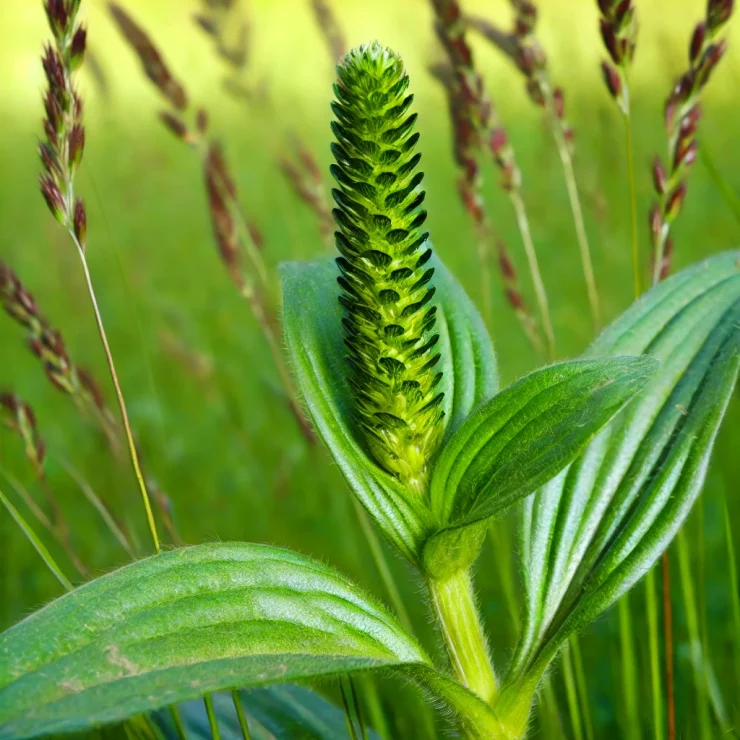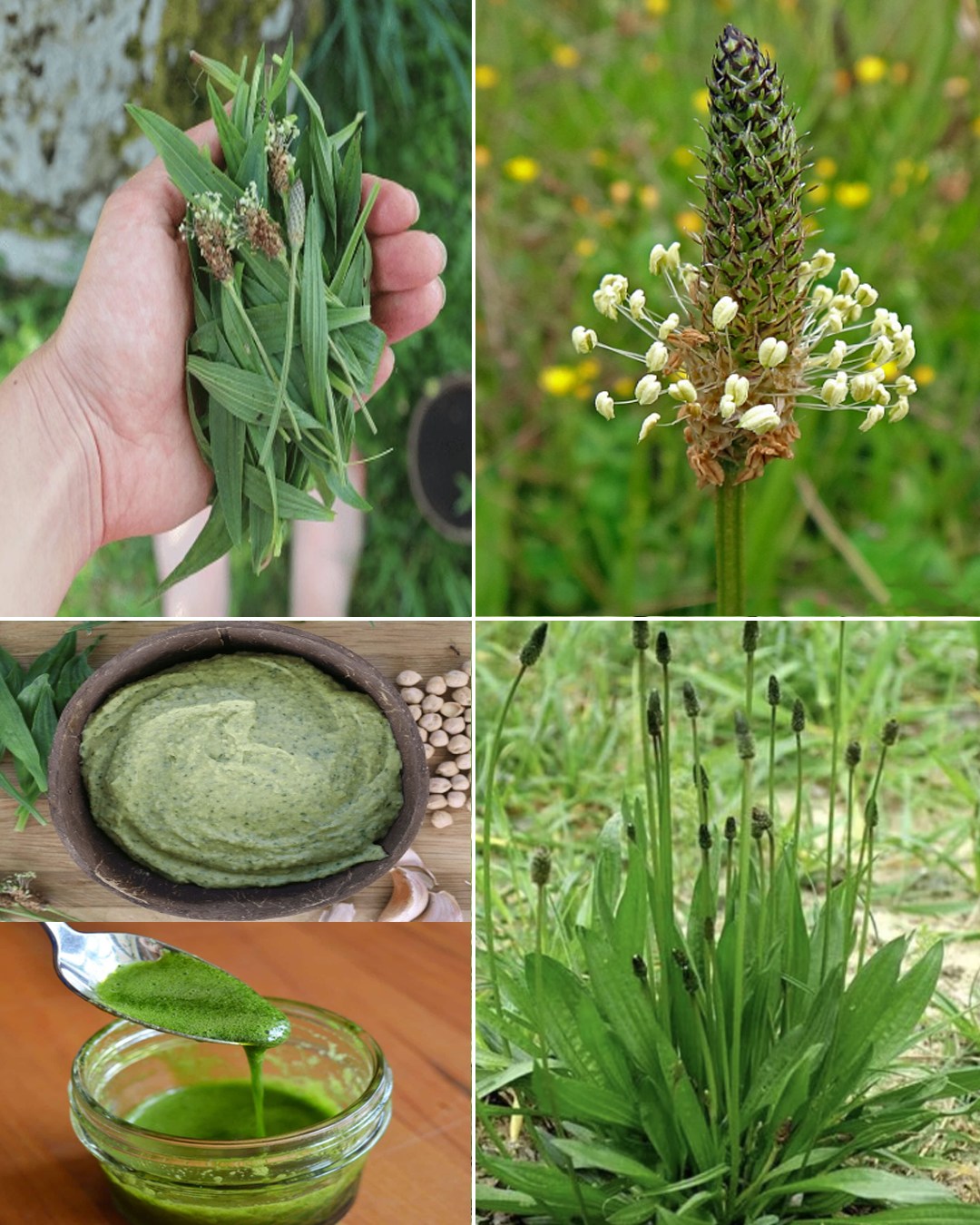While many people might see Narrowleaf Plantain (Plantago lanceolata) as just another weed in their backyard, this humble plant is actually a medicinal powerhouse. Often overlooked and underappreciated, Narrowleaf Plantain has been used for centuries in traditional medicine for its numerous health benefits. Whether you’re dealing with skin irritations, respiratory issues, or digestive problems, this resilient plant may be the natural remedy you’ve been searching for.

What Is Narrowleaf Plantain?
Narrowleaf Plantain, also known as Ribwort Plantain, English Plantain, or Lanceleaf Plantain, is a perennial herb that belongs to the Plantaginaceae family. The plant is easily recognized by its long, lance-shaped leaves with prominent parallel veins and tall, slender flower spikes. Native to Europe and parts of Asia, Narrowleaf Plantain has spread across the world and can now be found in a variety of environments, including lawns, gardens, roadsides, and meadows.
Despite its reputation as a common weed, Narrowleaf Plantain has a long history of use in traditional medicine, where it has been valued for its healing properties.
Medicinal Properties of Narrowleaf Plantain
Narrowleaf Plantain is packed with bioactive compounds that give it a wide range of medicinal properties. These include:
Anti-inflammatory: The plant contains aucubin, a compound with strong anti-inflammatory effects, making it useful for treating conditions like arthritis, insect bites, and other inflammatory issues.

Antimicrobial: Narrowleaf Plantain has natural antimicrobial properties that can help fight infections and prevent the growth of harmful bacteria and fungi.
Expectorant: The plant’s mucilage content helps soothe irritated mucous membranes, making it an effective remedy for respiratory conditions like coughs, bronchitis, and asthma.
Astringent: Narrowleaf Plantain’s astringent properties make it useful for tightening tissues, reducing bleeding, and speeding up wound healing.
Antioxidant: The plant is rich in antioxidants that help protect the body from oxidative stress and free radical damage.
Health Benefits of Narrowleaf Plantain
Thanks to its diverse range of medicinal properties, Narrowleaf Plantain can be used to address a variety of health concerns:
1.Treating Skin Conditions
One of the most common uses of Narrowleaf Plantain is for treating skin conditions. The leaves can be crushed to release their juice and applied directly to the skin to help heal cuts, scrapes, insect bites, and rashes. The plant’s anti-inflammatory and antimicrobial properties help reduce swelling, prevent infection, and promote faster healing.
How to Use:
Crush fresh Narrowleaf Plantain leaves and apply the juice directly to the affected area.
You can also make a poultice by mashing the leaves and placing them on the skin, covering with a bandage to hold it in place.
2.Soothing Respiratory Issues
Narrowleaf Plantain has been used for centuries as a remedy for respiratory problems. Its expectorant and anti-inflammatory properties make it particularly effective for relieving coughs, bronchitis, and asthma. The plant helps loosen mucus, making it easier to expel, while also soothing irritated airways.
How to Use:
Prepare a tea by steeping dried Narrowleaf Plantain leaves in hot water for 10-15 minutes. Drink this tea to help relieve respiratory symptoms.
3.Supporting Digestive Health
Narrowleaf Plantain is also beneficial for digestive health. It can help soothe irritated tissues in the digestive tract, reduce inflammation, and promote healthy digestion. The plant’s astringent properties are particularly useful for treating diarrhea and other digestive issues.
How to Use:
Drink Narrowleaf Plantain tea to help soothe digestive discomfort and promote gut health.
4.Healing Wounds and Reducing Inflammation
The astringent and anti-inflammatory properties of Narrowleaf Plantain make it an excellent natural remedy for wound healing. The plant can help reduce inflammation, stop bleeding, and promote the growth of new tissue. It is particularly effective for treating minor wounds, burns, and insect bites.
How to Use:
Apply crushed Narrowleaf Plantain leaves directly to the wound or make a salve using the leaves to speed up the healing process.
5.Relieving Pain and Swelling
In addition to its wound-healing abilities, Narrowleaf Plantain can also be used to relieve pain and swelling from injuries like sprains, strains, and bruises. The plant’s natural analgesic properties help reduce pain, while its anti-inflammatory effects help minimize swelling.
How to Use:
Apply a poultice of mashed Narrowleaf Plantain leaves to the affected area to relieve pain and reduce swelling.
How to Harvest and Use Narrowleaf Plantain
Narrowleaf Plantain is easy to find and harvest, especially if you live in an area where it grows abundantly. The best time to harvest the leaves is in the spring or early summer when they are young and tender.
To Use Fresh Leaves:
Wash the leaves thoroughly to remove dirt and debris.
Crush or mash the leaves to release their juice, which can then be applied to the skin or used to make a poultice.
To Make Tea:
Dry the leaves by spreading them out in a single layer in a warm, dry place.
Once dried, the leaves can be stored in an airtight container and used to make tea by steeping them in hot water.
Precautions
While Narrowleaf Plantain is generally considered safe for most people, it’s always a good idea to do a patch test before applying it to the skin, especially if you have sensitive skin or allergies. If you’re pregnant, breastfeeding, or taking medication, consult with a healthcare provider before using Narrowleaf Plantain, particularly in medicinal quantities.
Narrowleaf Plantain is a remarkable plant with a wide range of medicinal uses, yet it often goes unnoticed in our backyards. By recognizing and utilizing this overlooked medicinal marvel, you can tap into a natural remedy that has been valued for centuries. Whether you’re treating a skin condition, soothing a cough, or supporting your digestive health, Narrowleaf Plantain offers a safe and effective option right at your fingertips. So the next time you spot this “weed” in your yard, remember—it might just be the medicine you need.
News
(N) OFFICIAL : “Final verdict of the NCAA”: all of Lia Thomas’ Medals will be transferred to the beautiful Riley Gaines
The NCAA, college sports’ serial defendant, faces another federal lawsuit as more than a dozen female athletes sued the association, the University of Georgia and other defendants Thursday for alleged violations of Title IX, the Equal Protection Clause and the…
(N) Lia Thomas’ former teammates sue UPenn, Harvard and NCAA in lawsuit to scrub her records
Three former members of the University of Pennsylvania swimming team have taken action to expunge the women’s swimming records set by transgender former collegiate swimmer Lia Thomas. Grace Estabrook, Ellen Holmquist and Margot Kaczorowski, sued the university, Harvard University, the NCAA and the Ivy League Council…
(N) Openly transgender swimmer Lia Thomas speaks out against rhetoric regarding her NCAA win
Thomas’ Division I win sparked debates regarding transgender women playing women’s sports. The former UPenn swimmer says her transition has nothing to do with sports The unsigned statement comes after at least one anonymous member of the Penn women’s swimming…
(N) Lia Thomas out of Olympics after losing legal battle over transgender policy | Morning in America
Thomas made history in 2022, becoming the first transgender woman to win an NCAA swimming championship. Lia Thomas. Rich von Biberstein / Icon Sportswire via Getty Images file Transgender swimmer Lia Thomas lost a legal battle Wednesday challenging an effective ban on trans women competing…
(N) ‘SUCK IT UP’: Former UPenn swimmer sues Ivy league, NCAA over Lia Thomas
The controversy surrounding transgender athletes in competitive sports has once again made headlines as a former University of Pennsylvania swimmer has taken legal action against the Ivy League and the NCAA over their policies regarding transgender participation. The lawsuit, which…
(N) UPenn could face civil rights violation after trans athlete ban Lia Thomas
The University of Pennsylvania is among three colleges under investigation for a potential civil rights violation for allowing a transgender woman to compete in women’s sports. It follows President Donald Trump’s executive order banning transgender women from competing in women’s sports, where…
End of content
No more pages to load











